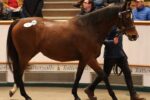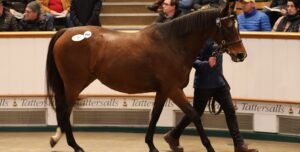No sooner had the curtain raised on 2023, then the sales industry hit the headlines for the wrong reasons when it was revealed that auction houses had yet to receive payment for approximately £20.5 million worth of yearlings bought last year by agent Richard Knight. Although Knight has never publicly confirmed the identity of his client, it is widely believed to be Kuwaiti businessman Saleh Al Homaizi, a returning figure to the game who tasted Classic success as the co-owner of Authorized and Araafa.
This is a fast-moving situation but at the time of writing, Tattersalls had taken steps to retrieve payment of approximately 11 million guineas by alerting potential buyers via email to the possibility of being able to acquire the 17 yearlings bought out of its October Sale ‘by private sale with immediate effect or at sale/sales to confirmed’. The newly-turned two-year-olds include a Frankel colt out of Bold Lass bought for 2,000,000gns and a Lope De Vega half-sister to Battaash bought for 1,800,000gns.
Nor does it end there as plenty was also spent on yearlings at Arqana (€1.98 million), Keeneland ($4.875 million) and Goffs, where Knight outbid Jacob West at €2.6 million for the No Nay Never sister to Blackbeard.
This isn’t the first time that a person has defaulted on payment out of an auction, nor will it be the last. However, the volume of horses and money involved appears to be unprecedented, in the racing world at least. As such, the first reaction when the news finally became public was how on earth could this have happened. But in fairness, this is a case of a returning owner, one
who campaigned and bred a number of top horses with success for more than two decades before his shift away from the sport in 2018. He was a well known figure on the racecourse and at the sales, where in partnership his previous yearling purchases included the €1.2 million top lot at the 2014 Arqana August Sale.
That provides some explanation as to how events were allowed to unfold. Nevertheless, the repercussions are too far-reaching for the industry to let it pass. Questions should be asked on how matters were able to progress so far, and measures need to be put in place to prevent something of this magnitude from happening again.
Of course, it could be that the problem will shortly be resolved. Until that either happens or the horses are re-offered, the immediate headache is that these are living and breathing animals on a programme – one that currently comprises pre-training – aimed at maximising their potential. Regardless of their one-time value in the ring, the horses are now likely to be at different stages of their education with some coping better than others. In other words, time is of the essence.
FAREWELL SIR PATRICK HOGAN
New Zealand racing bid farewell to one of its largest characters last month with the death of Sir Patrick Hogan at the age of 83. From 1976 until 2017, Hogan and his wife Justine bred numerous Group 1 winners at their Cambridge Stud, with his foresight and understanding of stock and the business key in developing the Cambridge name into a dominant southern hemisphere presence.
One of the turning points came in 1976 with the arrival of Sir Tristram as a foundation stallion. The son of Sir Ivor boasted just two wins in 17 starts while even Hogan’s agent advised against his purchase. However, Hogan was determined to secure him, a decision for which he was vindicated many times over when the horse became a six-time champion sire in Australia and nine-time champion sire in New Zealand. At one time available for just NZ$1,500, Sir Tristram commanded NZ$250,000 at the peak of a career highlighted by 45 Group 1 winners.
Similarly, Hogan crafted Sir Tristram’s son Zabeel into a multiple champion sire on both sides of the Tasman Sea; today, Zabeel’s legacy continues to run deep within Australasia through his son Savabeel, who has been New Zealand’s leading sire every season since 2014 – 15.
The popularity of Sir Tristram and Zabeel were driving forces behind Cambridge Stud’s uninterrupted 31- year reign as leading vendor at the New Zealand Bloodstock National Yearling Sale. However, so too was Hogan’s attention to detail when it came to preparing and presenting sales stock. Someone who was ahead of his time, he brought a game-changing approach to the marketing and selling of horses, at one stage going so far as to fly Australian-based buyers over to the sales.
The number of respected stud masters and horsemen to have worked under him at Cambridge also provides testament to his skills as a mentor.
Cambridge was sold to Brendan and Jo Lindsay in 2017 and remains an important part of the New Zealand bloodstock landscape, notably as the southern hemisphere home to French shuttle stallions Almanzor and Hello Youmzain. However, it will always be inextricably linked to Hogan, the man who helped draw unprecedented international attention to the New Zealand bloodstock industry.



